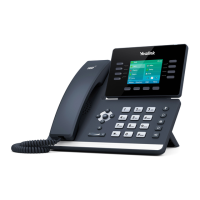Setting Up Your System
101
Address Restricted Cone NAT
Restricted cone NAT works similar like full cone NAT. A public host (hAddr: any) can send
packets to iAddr: port1 through eAddr: port2 only if iAddr: port1 has previously sent a packet
to hAddr: any. "Any" means the port number doesn't matter.
Port Restricted Cone NAT
Port restricted cone NAT works similar like full cone NAT. A public host (hAddr: hPort) can send
packets to iAddr: port1 through eAddr: port2 only if iAddr: port1 has previously sent a packet
to hAddr: hPort.
NAT Traversal
In the VoIP environment, NAT breaks end-to-end connectivity.
NAT traversal is a general term for techniques that establish and maintain IP connections
traversing NAT gateways, typically required for client-to-client networking applications,
especially for VoIP deployments. Yealink IP phones support three NAT traversal techniques:
manual NAT, STUN and ICE. If manual NAT and STUN are all enabled, the IP phone will use the
manually configured external IP address for NAT traversal. The TURN protocol is used as part of
the ICE approach to NAT traversal.
Manual NAT (Static NAT)
Manual NAT helps IP connections traverse NAT gateways without the third-party network
server (STUN/TURN server). If manual NAT feature is enabled, the configured public IP address
and port can be carried in the SIP requests or RTP packets, in which the other party obtains the
phone’s public address. It is useful to reduce the cost of the company’s network deployment.

